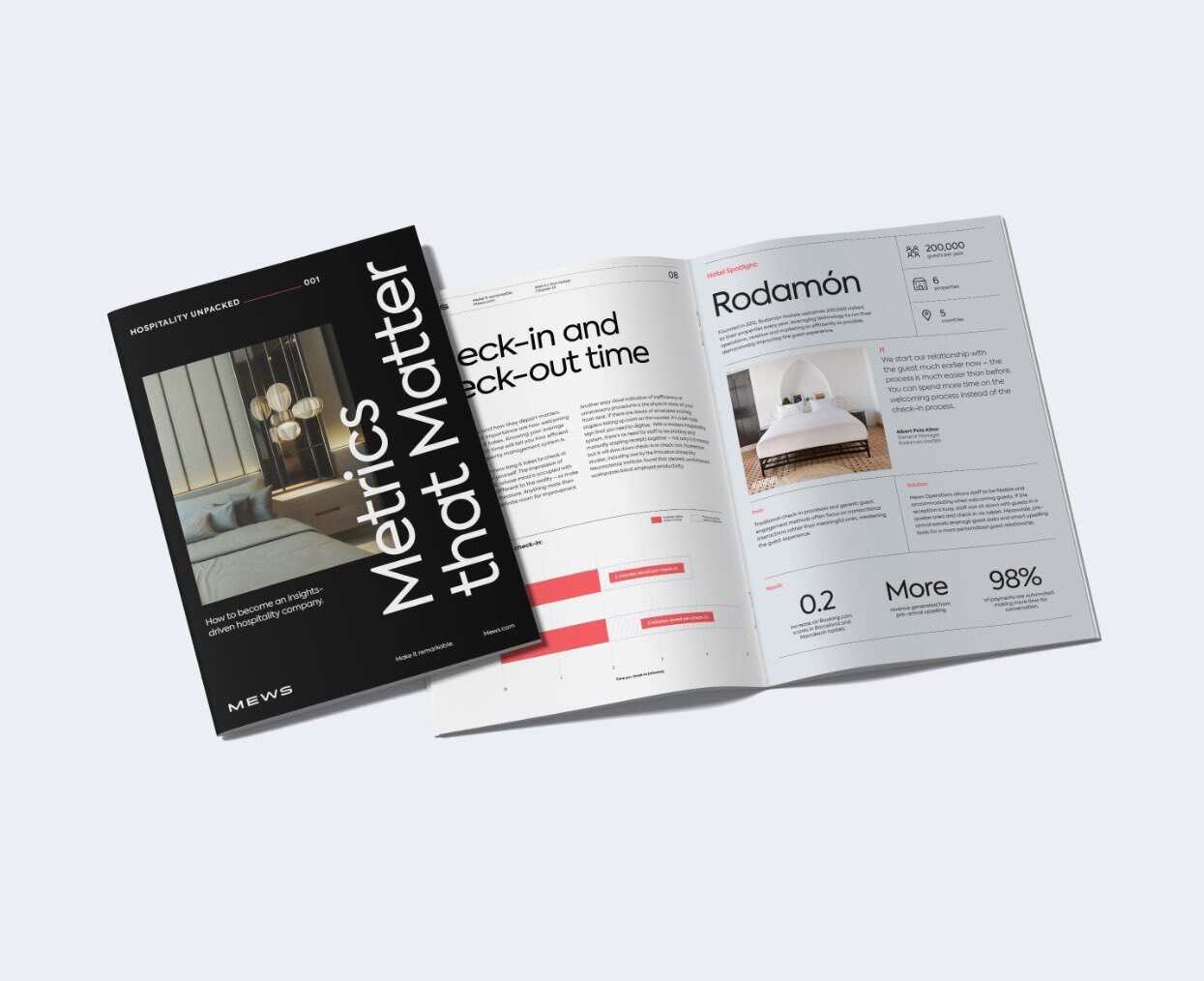If you want a clear picture of your property's overall performance, consider getting to know the TRevPAR metric. While RevPAR is valuable for tracking room revenue, TRevPAR goes one step further by capturing revenue from all departments — whether it's rooms, food and beverages, spa amenities or other services. Essentially, it provides an overarching view of your property's total earning potential, giving you insights that RevPAR alone can’t offer.
Table of contents
What is TRevPAR in hotels?
TRevPAR, or Total Revenue per Available Room, is a hotel KPI that helps you gauge how effectively your property is generating revenue. It can significantly improve your revenue management strategy by offering a comprehensive view of the total income a hotel makes across departments using a per-available-room basis.

Why is the TRevPar important?
TRevPAR is a crucial metric for analyzing a hotel’s performance. It allows hoteliers to evaluate how well their property is meeting its goals and how it stacks up against the competition. By considering both average daily rate and occupancy, hotels can gain deeper insights into their revenue-generating potential, which in turn helps with more accurate forecasting for pricing, marketing and operational costs.
TRevPAR also informs decisions about room rates, additional services, cost structures, and marketing strategies, all with the aim of boosting occupancy rates and overall revenue. By leveraging this KPI, hoteliers can make smarter, data-driven decisions that directly impact their bottom line.
What’s the difference between TRevPAR and RevPAR?
The main difference between RevPAR and TRevPAR is that RevPAR calculates only the revenue generated from room sales, while TRevPAR considers the total revenue generated per room. Although they are similar, TRevPAR provides a clearer view of overall hotel performance by factoring in all revenue streams, not just room rates.
That said, RevPAR still plays an important role in tracking revenue from rooms, which is typically the largest revenue stream for a hotel. It remains a key metric and the most common comparison point for hoteliers.
How to calculate the TRevPAR metric
Calculating TRevPAR is straightforward: simply divide the total net revenue by the total number of available rooms during a specific period. The formula looks like this:
TRevPAR = Total Revenue / Rooms Available
In this equation, TRevPAR represents the total net revenue per available room. "Total revenue" includes all income generated by the hotel, such as room bookings, food and beverages, amenities and any other add-ons. "Rooms available" refers to the number of rooms that were available during the time frame.
TRevPAR provides a comprehensive measure of a hotel’s ability to generate revenue from its available inventory, encompassing all revenue streams, not just room sales. This metric works alongside other key indicators like the Average Daily Rate (ADR) and occupancy rate, offering a fuller picture of a hotel’s overall financial performance.
What are the benefits of TRevPAR for hospitality?
We’ve briefly mentioned the benefits of this calculation to the hospitality sector, but now let’s dive into them in more detail.
Take revenue into consideration across all departments
In the hotel industry, every revenue stream matters — from room bookings to food and beverage sales, parking fees, event hosting, and spa services. The TRevPAR equation shines here, as it captures revenue from all departments, not just the rooms. This comprehensive approach ensures that no income source is overlooked, giving you a fuller picture of your hotel’s financial performance.
Show the big picture
Understanding the big picture of your hotel’s profitability is essential, and TRevPAR is designed to do just that. By looking at total revenue across the board, this metric helps you shape your strategy with a complete perspective.
For example, you can compare revenue contributions from different departments with TRevPAR and operational metrics to identify where to invest resources. If your spa revenue significantly boosts TRevPAR, it might be time to consider enhancing that department further.
Find opportunities to beat out the competition
A key aspect of any revenue management strategy is assessing how your hotel’s revenue streams stack up against the competition. By comparing your fees across various departments, you can spot opportunities to outmaneuver competitors and boost your TRevPAR. For instance, if you notice that your competitors charge more for spa services, you might consider raising your spa fees to capture more revenue from that department.
Pinpoint fluctuations over different periods
The TRevPAR equation also helps you track revenue fluctuations across different periods, enabling you to fine-tune your strategy in response. Together with closely analyzing your hotel data analytics, you can make decisions to target certain departments within your hotel that positively impact your hotel’s revenue.
For example, if you find that your spa services generate significantly higher revenue during the winter months, you could increase marketing efforts for the spa during that period to maximize returns.
Get insights into consumer behavior
Understanding consumer behavior is crucial for any hotel aiming to tailor its services to meet customer needs. By tracking data across various departments, you can see how your decisions impact consumer behavior, pricing and demographics. These insights are invaluable for customizing your marketing and sales strategies to better resonate with your target audience.
Additionally, by monitoring revenue across departments, you gain a clearer picture of each department’s contribution to overall revenue. This allows you to design a more focused strategy to boost this key performance indicator (KPI).
Revenue managers should aim to maximize all revenue-generating departments. After all, the value of add-on services like restaurants, spas, and other amenities lies in how well they appeal to consumers. By understanding which add-on services consumers respond well to, hotels can find ways to maximize these alternative sources of revenue so that they don’t only rely on rooms. This brings us to the last benefit.
Expand ancillary revenue sources
Ancillary revenue comes from the products, services, and extras booked daily. Expanding these revenue streams allows hotels to diversify their income, providing a buffer during periods of low room demand. In such times, hotels can shift their focus to making these non-room services more profitable.
Identify untapped opportunities and weaknesses
TRevPAR is a great metric to help you pinpoint untapped opportunities and weaknesses. If you find that this metric is considerably lower during a certain period, you can see what you changed during that period or consider your fee structures for additional services. Or say, for example, that your total revenue is low, you can consider using marketing strategies to drive people to your restaurant, bars and room-service opportunities.
Improved forecasting
TRevPAR is a valuable tool for forecasting, offering a comprehensive view of a hotel’s financial health. By using this metric, you can make more informed budgeting and forecasting decisions. It not only aids in planning but also allows you to track your progress by closely monitoring changes over time, helping you stay on target with your financial goals.

How can you increase TRevPAR for your hotel?
There are different ways that you can approach increasing TRevPAR for your hotel.
Boost your service offering
Elevating your service offering not only enhances guest satisfaction but also contributes to your total revenue. Introduce value-driven services like room service, laundry, upgraded restaurant menus, or signature cocktails at your hotel bar. These additions encourage guests to spend more during their stay.
Create targeted marketing campaigns
TRevPAR offers insights into underperforming areas of your hotel’s revenue. Using a hotel revenue management system, you can analyze these insights and create targeted marketing campaigns that close those gaps. For example, if guests aren’t upgrading or using on-site services, offer enticing incentives. Running limited-time promotions for room upgrades or offering discounts on-site can boost spending and increase overall revenue.
Drive efficiency with automation
Automation may not seem like a direct revenue booster, but it’s key to increasing efficiency. Automated check-ins and check-outs reduce the front desk workload, lowering fixed costs and allowing staff to focus on revenue-generating tasks rather than time-consuming manual processes.
Personalization
Although personalization doesn’t directly increase revenue, it encourages guests to spend more during their stay. You can enhance personalization by creating guest profiles, tracking repeat guests' preferences, and tailoring your offerings to match their past behavior. This approach makes it easier to entice guests to purchase additional services, contributing to higher overall revenue.
Encourage direct bookings
Direct bookings are an ideal way to reduce customer acquisition costs, allowing your hotel to achieve higher margins and revenue. To encourage more direct bookings, invest in search engine optimization (SEO) and search engine marketing (SEM). Additionally, offer exclusive deals for guests who book directly through your website. Implementing retargeting strategies can also be effective, as they allow you to reach guests who have already visited your site, encouraging them to complete their booking.
Conclusion
While TRevPAR isn’t the ultimate measure of your hotel’s success, it offers a valuable broad view of performance. It’s essential to keep in mind that TRevPAR doesn’t factor in all expenses or occupancy levels, so it shouldn't be your only measure of profitability. Still, it serves as an excellent starting point.
In the constantly shifting hotel industry, maintaining a diverse mix of revenue streams is critical. By closely tracking TRevPAR, hoteliers can identify underperforming areas and uncover opportunities to drive profit, especially during periods of low room revenue.
Filling rooms is just one piece of the puzzle. The other is maximizing revenue through amenities, upgrades, and food and beverage services. Using TRevPAR to get the full picture allows you to build a revenue strategy that optimizes profitability and gives you a competitive edge.
Download our guide "The Metrics that Matter"
The metrics we've just explored are among the most common in hospitality, but that doesn't mean they're the best. We've put together a report, Metrics that Matter, that will help you to maximize revenue and boost the guest experience, all by tracking the right data. Click the button below to find out how you can be more efficient across operations, revenue and marketing.





.webp)
